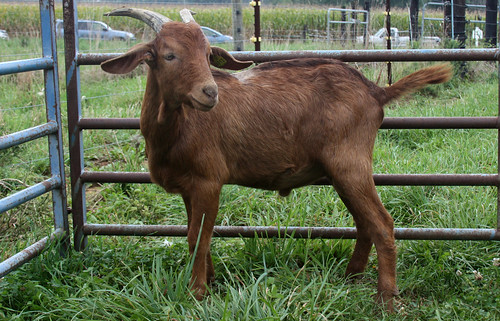Measurements ranged from 17 to 28 cm and averaged 24.7 cm. While there aren’t any minimum standards (yet) for bucklings, mature bucks should have a scrotal circumference of at least 25 cm (10 inches).
It was noted if the buck had a scrotal split. While a few of the bucks had slight scrotal splits, none had big enough splits to be concerned about. In some breed registries, scrotal splits may not exceed 1 inch. In other breed registries, a 2 inch (6 cm) split is allowed. Excessive scrotal splits may affect a buck's fertility. He may pass this trait onto his offspring.
 Teats were counted. Goats should have no more than two functional teats per side. One teat per side is ideal and preferred by many goat producers. Abnormal teats were noted. Kids may not be able to nurse extra or deformed teats.
Teats were counted. Goats should have no more than two functional teats per side. One teat per side is ideal and preferred by many goat producers. Abnormal teats were noted. Kids may not be able to nurse extra or deformed teats.Forty-three of the bucks had two teats with no observed abnormalities. These bucks will pass their correct teat structure onto their offspring. Supernumary (or extra) teats is a heritable trait.
The goats were mouthed to determine the correctness of their bite. Ideally, the goat’s lower front teeth should be even with its dental pad. An underbite is when the lower jaw is longer than the upper jaw. An overbite is just the opposite. While five of the bucks were determined to have slight underbites, none were considered to be serious enough faults to disqualify them from the sale.
After the goats were finished being worked on the elevated platform, they were moved to an 8 x 8 ft. pen so we could observe them on the move and evaluate them for structural correctness. Several bucks were determined to be slightly cow or sickle-hocked. A few of the bucks were post-legged.
When an animal is cow hocked, its back knees are set inwards. Sickle-hocked is when the back leg joints are set with too much angle. When an animal is post-legged, its leg joints are too straight. There were only two bucks whose structure makes them questionable entries in the sale.
The supplemental data report also includes treatment (Tx) information for each buck. Over the course of the test, some of the goats have been treated for lice, ringworm, infected ears and eyes, scours, abscesses, and fevers. Treatment for a fever is considered to be the most serious need of the buck.
Download supplemental data report.











